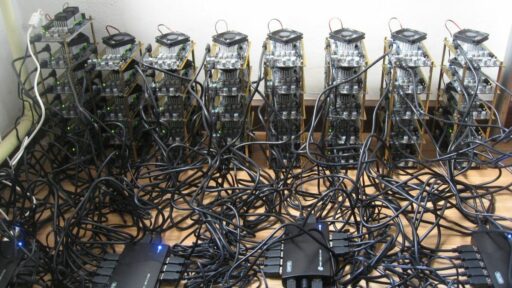Cryptocurrency mining has become a crucial part of the digital currency ecosystem, providing a way for individuals to contribute to the security and decentralization of blockchain networks while potentially earning rewards. This ultimate guide aims to equip aspiring miners with the knowledge and tools needed to start their crypto mining journey, covering everything from the fundamentals of mining to advanced strategies for optimizing operations.
Key Takeaways
- Cryptocurrency mining is vital for maintaining blockchain security and offers a potential source of income.
- Understanding the differences between Proof of Work and Proof of Stake is essential for selecting a mining approach.
- The right hardware and software, combined with a strategic choice of mining pool, can significantly impact profitability.
- Staying compliant with local regulations and understanding tax implications are critical to a legitimate mining operation.
- Continuous learning and adapting to new technologies and trends are necessary to remain competitive in crypto mining.
Understanding Cryptocurrency Mining Fundamentals

The Role of Mining in Blockchain Technology
Cryptocurrency mining is the bedrock of the blockchain ecosystem, providing both transaction verification and the creation of new coins. Miners are the auditors of the crypto world, ensuring the integrity of the decentralized ledger while also being rewarded for their efforts with new cryptocurrency units.
Mining has evolved from using basic CPUs to powerful ASICs, marking a significant advancement in mining technology. Here’s a brief timeline of this evolution:
- CPUs: The early days of mining, accessible to hobbyists.
- GPUs: A step up in power and efficiency.
- FPGAs: Introduced programmability to mining.
- ASICs: Currently the pinnacle of mining hardware, designed specifically for mining efficiency.
The shift to ASICs has redefined the mining landscape, making it more competitive and professionalized. Understanding this technological progression is essential for anyone entering the mining space.
As the blockchain network grows, the role of miners becomes increasingly critical. They not only maintain the network’s functionality but also secure it against potential attacks, making mining an indispensable component of the blockchain’s infrastructure.
Proof of Work vs. Proof of Stake
The cryptocurrency world is witnessing a paradigm shift with the adoption of Proof of Stake (PoS) mechanisms over the traditional Proof of Work (PoW). PoS emerges as an energy-efficient alternative, where the probability of validating transactions and creating new blocks is proportional to one’s stake in the network. This method not only reduces the computational power required but also democratizes the mining process to a broader audience.
In PoS systems, validators play a crucial role. They are akin to the miners in PoW, but instead of solving complex puzzles, they are chosen based on the amount of cryptocurrency they stake. The staking process involves locking up coins to support network security and operations, which in turn, rewards validators with additional coins. It’s a less resource-intensive approach that has been gaining traction for its accessibility and sustainability.
Staking in PoS networks is not without its responsibilities. Validators must ensure the integrity and security of the network. Any mismanagement or technical failures can lead to penalties, which might reduce earnings or even cost a portion of the stake. This accountability is crucial for maintaining a trustworthy and efficient blockchain.
While PoW has been the backbone of networks like Bitcoin, PoS is being adopted by modern cryptocurrencies for its potential to offer a more scalable and environmentally friendly mining solution. Ethereum’s transition to a PoS system exemplifies this shift towards a more cost-efficient consensus mechanism.
Evaluating Profitability: Costs vs. Rewards
To embark on a profitable crypto mining venture, it’s crucial to analyze the power and running expenses of your operation. Mining profitability calculators are indispensable tools for this purpose, as they factor in hardware efficiency, electricity costs, and the current cryptocurrency prices. These calculators also consider the network’s current and future difficulty levels, allowing for a more nuanced forecast of potential earnings.
Costs to consider extend beyond electricity to include transaction fees, maintenance, and potential equipment upgrades. Market competition is another critical factor, as it influences the likelihood of successfully mining new blocks. For individual miners, strategies like cloud mining or joining a mining pool can be effective in balancing costs with rewards.
Improved cost control and higher profit margins can be achieved by adapting to advancements in mining technology and energy-saving techniques. Regularly updating mining methods in response to market conditions is essential for optimizing profitability.
Setting Up Your Mining Operation

Choosing the Right Hardware
Selecting the optimal hardware is a critical step in establishing a profitable mining operation. The hash rate, power consumption, and cost are the three pillars that will determine your mining rig’s efficiency and success. Miners have a variety of options, including CPUs, GPUs, FPGAs, or ASICs, each with its own advantages and tailored to different mining needs.
When considering hardware, it’s essential to match your choice with the cryptocurrency you plan to mine. For instance, Bitcoin mining requires hardware capable of solving the SHA-256 algorithm, whereas Ethereum mining might be more suited to GPUs due to the Ethash algorithm.
Remember, investing in the latest technology not only boosts processing speed but also ensures energy efficiency, which is crucial for long-term profitability.
Here’s a quick checklist to guide you through the hardware selection process:
- Research the mining algorithm used by your chosen cryptocurrency.
- Evaluate the compatibility of potential hardware with that algorithm.
- Consider the balance between initial cost and potential mining rewards.
- Keep in mind the importance of cooling systems to maintain hardware performance and longevity.
Mining Software Essentials
Once you have your mining hardware in place, the next critical step is to install mining software that will orchestrate your mining efforts. The right software will communicate with the blockchain network, manage your hardware’s hash rate, and direct the mined coins to your wallet. It’s essential to choose software that is compatible with both your hardware and the cryptocurrency you intend to mine.
Popular mining software includes CGMiner, Awesome Miner, and EasyMiner, each offering different features and levels of customization. Here’s a quick rundown of some widely-used mining software:
- CGMiner: Known for its versatility and open-source build, allowing for various customizations.
- Awesome Miner: A powerful option that supports multiple mining engines and can manage several types of mining hardware.
- EasyMiner: Boasts a user-friendly interface, making it suitable for beginners.
Optimizing your software settings is crucial for efficiency. This involves configuring your wallet address, selecting the right mining pool, and adjusting settings for optimal energy consumption without compromising performance. Remember, the goal is to maximize profitability by balancing the cost of electricity against the rewards earned from mining.
It’s important to regularly update your mining software to the latest version to ensure maximum efficiency, security, and compatibility with the latest blockchain protocols.
Joining a Mining Pool: Pros and Cons
When venturing into crypto mining, deciding whether to join a mining pool is a critical choice. Mining pools combine the computational power of multiple miners, increasing the chances of successfully mining a block and receiving rewards. This collaboration can lead to a more consistent income stream compared to the unpredictable nature of solo mining.
However, it’s important to consider the trade-offs:
-
Pros:
- Steadier income flow
- Lower entry barriers for new miners
- Reduced impact of mining luck
-
Cons:
- Smaller reward per block, as it’s shared
- Pool fees can reduce profitability
- Less control over the mining process
When selecting a mining pool, research is key. Look for pools with a reputation for fair reward distribution and transparency. Consider the fee structure and the pool’s size, as larger pools may offer more frequent payouts but smaller individual rewards. Ultimately, your choice should align with your mining goals and resources.
Navigating Legal and Regulatory Aspects

Understanding Your Local Regulations
Before embarking on your crypto mining journey, it’s crucial to understand the legal landscape in your area. Cryptocurrency regulations can vary significantly from one country to another, and even within regions of the same country. Some governments welcome crypto mining with open arms, offering incentives and clear guidelines, while others impose strict regulations or outright bans.
- Research local laws and regulations regarding cryptocurrency mining.
- Determine if any permits or licenses are required to operate legally.
- Stay informed about changes in legislation that could affect your mining activities.
It is essential to ensure that your mining operation is fully compliant with local laws to avoid any legal repercussions.
Remember, the legal status of cryptocurrencies, including mining, is an evolving issue. As such, staying updated with the latest information is not just advisable; it’s necessary for the longevity and legality of your mining operation. Countries like the United States, Canada, and various European nations have frameworks in place, while others may have more ambiguous or restrictive stances.
Tax Implications of Mining Rewards
Understanding the tax implications of mining rewards is essential for any crypto miner. Mining rewards are considered taxable income in many jurisdictions, and failing to report them can lead to significant penalties. It’s important to keep detailed records of all mining activities, including the date of reward acquisition and the market value at that time.
- Record the date and market value of each mining reward
- Include mining rewards as income on tax returns
- Deduct any allowable expenses related to mining operations
Tax laws vary by country and can change frequently, so staying informed and consulting with a tax professional is advisable.
Crypto mining involves navigating complex legal challenges, including regulatory compliance, taxation, anti-money laundering, and environmental laws. Adapting to evolving legislation is crucial for miners’ success. Keeping abreast of tax regulations and preparing for filing can save miners from unexpected tax liabilities and ensure a smoother mining journey.
Ensuring Compliance and Avoiding Penalties
In the ever-evolving landscape of the crypto mining industry, staying compliant with legal requirements is crucial. As the industry faces increasing regulatory scrutiny globally, miners must navigate a complex web of laws that can vary significantly by jurisdiction. To ensure compliance and avoid costly penalties, miners should consider the following steps:
- Stay informed about the latest regulatory developments in your area.
- Consult with legal experts who specialize in cryptocurrency regulations.
- Implement compliance protocols within your mining operations.
- Regularly review and update your compliance measures to adapt to new laws.
Focusing on eco-friendly mining solutions is not only beneficial for sustainability but may also be a regulatory requirement in the near future.
Remember, non-compliance can lead to severe penalties, including fines and the shutdown of mining operations. Therefore, it’s essential to prioritize legal compliance as part of your mining strategy.
Optimizing Your Mining Strategy

Energy Efficiency and Sustainability
In the realm of crypto mining, energy efficiency is not just an environmental concern but a critical economic factor. Miners are increasingly seeking ways to reduce their carbon footprint while enhancing profitability. Utilizing renewable energy sources, such as solar or wind power, can lead to significant savings on electricity bills and transform the financial dynamics of mining operations.
By optimizing energy consumption, miners can turn electricity into a strategic asset rather than a financial burden.
Here are some practical steps to improve energy efficiency:
- Assess the energy consumption of your mining hardware.
- Explore renewable energy options and their feasibility for your location.
- Implement cooling solutions to reduce heat waste.
- Relocate mining operations to regions with lower electricity costs or cooler climates.
Remember, the goal is to achieve a balance between sustainability and profitability, ensuring that your mining venture remains viable in the long term.
Advanced Mining Techniques
To excel in crypto mining, it’s crucial to employ advanced mining techniques that go beyond the basics covered in a beginner’s guide. One such technique involves optimizing cooling systems to ensure hardware longevity without sacrificing mining performance. This balance is key to maintaining a profitable operation.
Efficient energy usage is another cornerstone of advanced mining. By understanding the dynamics of electricity usage, hardware costs, and maintenance, miners can structure their operations around energy-saving programs that do not compromise on performance. Here’s a quick rundown of factors to consider:
- Awareness of price dynamics
- Hardware performance and longevity
- Power consumption minimization
By incorporating precise calculations of mining profitability into your strategy, you can make informed investment decisions and potentially achieve high returns from Bitcoin mining.
Remember, the goal is to create a setup that is both efficient and sustainable, ensuring that your mining rig not only performs well but also stands the test of time.
Monitoring and Adjusting Your Setup
To maintain a competitive edge in crypto mining, regular monitoring and timely adjustments of your mining setup are crucial. This involves keeping a close eye on performance metrics such as hash rate, temperature, and overall system health. Routine maintenance tasks, such as cleaning dust from components and replacing aging parts, can significantly extend the lifespan of your mining hardware.
By proactively managing your mining operation, you can ensure that your equipment runs efficiently, thereby optimizing profitability and minimizing downtime.
Staying informed about the latest industry news and technological advancements is also key to adapting your strategy to the ever-changing mining landscape. Use the following checklist to streamline your monitoring process:
- Review hash rate and temperature logs daily
- Conduct weekly hardware inspections for wear and tear
- Schedule monthly performance evaluations to compare against benchmarks
- Adjust mining software settings as needed to optimize performance
Remember, the cryptocurrency ecosystem is dynamic, and what works today may not be as effective tomorrow. Continuously assess your setup and be prepared to pivot your strategy to stay ahead of the curve.
Staying Ahead in the Crypto Mining Game

Keeping Up with Industry Trends
In the ever-evolving world of cryptocurrency mining, staying informed about industry trends is crucial for maintaining a competitive edge. Keeping abreast of technological advancements can mean the difference between a profitable operation and one that falls behind. It’s not just about the latest hardware; it’s also about understanding shifts in market dynamics and regulatory landscapes.
- Blockchain integration in traditional sectors
- Technological innovations for safety and efficiency
- Market and regulatory updates
To succeed in the dynamic cryptocurrency realm, one must navigate regulatory challenges and stay informed on market trends.
Adapting to new trends may require miners to reassess their strategies periodically. This could involve exploring new blockchain applications, such as those emerging in Industry 4.0, or implementing advanced safety measures that leverage technology to protect operations.
Security Best Practices for Miners
In the realm of crypto mining, security is paramount. Always prioritize the protection of your mining setup to prevent unauthorized access and potential losses. Here are some essential best practices:
- Use strong, unique passwords for all mining-related accounts and wallets.
- Enable two-factor authentication (2FA) wherever possible to add an extra layer of security.
- Keep your mining software and hardware firmware up to date to protect against vulnerabilities.
- Be vigilant against phishing attempts and suspicious links that may compromise your operation.
Protecting your mining rig from cryptojacking is crucial. Ensure that you are not inadvertently mining for someone else by maintaining robust security measures and regularly scanning for malware.
Remember, the safety of your mining operation not only secures your current assets but also ensures the longevity and profitability of your mining endeavors. Stay informed about the latest security threats and continuously refine your security protocols to stay ahead of potential risks.
Planning for the Future: Scalability and Upgrades
As you delve deeper into the crypto mining world, planning for scalability and upgrades becomes crucial for long-term success. It’s not just about growing your operation in size but also about enhancing its efficiency and adaptability to change.
- Stay informed about the latest developments in mining technology.
- Plan for hardware upgrades to keep your operation efficient and profitable.
- Consider the potential for expanding your mining setup or diversifying into different cryptocurrencies.
Ensuring that your mining operation can scale up or pivot as necessary is vital. This may involve investing in modular systems that can be easily expanded or updated as technology evolves.
Remember, the landscape of cryptocurrency mining is constantly shifting. New advancements in hardware and software, as well as changes in network difficulty and coin value, can all affect your mining strategy. Being prepared to invest in new technology and to adapt your approach is essential for maintaining a competitive edge.
Conclusion
Embarking on your cryptocurrency mining journey is an exciting step into the world of blockchain technology. Throughout this guide, we’ve explored the critical aspects of starting your mining endeavor, from securing a digital wallet and selecting efficient hardware to joining mining pools and staying abreast of industry developments. Remember, mining is not just about the potential financial rewards; it’s about participating in and upholding the decentralized ethos of cryptocurrency. As you proceed, keep in mind the importance of legal compliance, energy efficiency, and ongoing education to navigate the complexities of this dynamic field. With diligence and adaptability, you can carve out your niche in the crypto mining landscape.
Frequently Asked Questions
What is cryptocurrency mining and why is it important?
Cryptocurrency mining is the process of verifying and adding transactions to a blockchain network, which secures and decentralizes the system. It’s important because it ensures the integrity and chronological order of transactions, making the network trustworthy.
How does Proof of Work differ from Proof of Stake?
Proof of Work requires miners to solve complex mathematical problems to validate transactions and create new blocks, consuming significant energy. Proof of Stake, on the other hand, selects validators based on the number of coins they hold and are willing to ‘stake’ as collateral, which is more energy-efficient.
What factors should I consider when evaluating the profitability of crypto mining?
To evaluate mining profitability, consider the cost of hardware, electricity, and maintenance, as well as the current price of the cryptocurrency, block rewards, and network difficulty. Tools like mining calculators can help estimate potential earnings.
What are the legal and tax implications of cryptocurrency mining?
Legal and tax implications vary by region. Miners must comply with local regulations, which may include registering the operation, adhering to energy consumption standards, and reporting mining rewards as income for tax purposes.
How can I optimize my mining setup for better efficiency and sustainability?
To optimize your mining setup, focus on energy-efficient hardware, consider renewable energy sources, use advanced mining techniques like overclocking with caution, and regularly monitor and adjust your setup for optimal performance.
What are the best practices for ensuring security in my mining operation?
Best security practices include using secure and updated mining software, protecting your digital wallet with strong passwords and two-factor authentication, joining reputable mining pools, and staying informed about potential security threats in the crypto mining industry.





